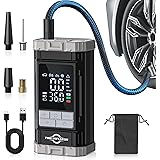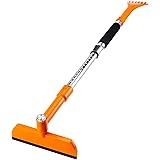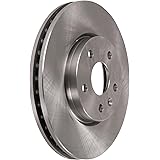Table of Contents

On a warm summer evening, as the sun starts to go down, your mind races with thoughts of the exciting adventure that is about to happen. The open road calls to you, asking you to go on a trip to learn and see new things.
But before you can go on your big adventure, you have to do one important thing: prepare an old car for a long trip.
Whether it’s a vintage beauty or a trusty companion that has weathered countless miles, ensuring its readiness is essential for an unforgettable voyage.
In this article, we’ll talk about the steps and precautions you need to take to get your favorite car in its best condition. This will make sure you have a smooth ride as you travel across vast landscapes and make memories along the way.
How to Prepare an Old Car For a Long Trip?
An old car presents a unique set of challenges when preparing for a long trip. Here are a few tips to help make the process as smooth as possible.
Consider taking your car to a mechanic if you don’t know what you’re doing when it comes to car maintenance.
For your convenience, we have divided these steps into the
Exterior
Interior
Tires
Car Exterior:
Maintain the Engine:

One of the most important aspects of driving an old car long distance is making sure that your car is in good condition. This means checking the engine and doing any necessary maintenance or repairs.
If your car is old, it’s especially important to make sure that everything is in working order, as it may not be able to handle the rigors of a long trip.
Here are a few tips for maintaining your old car’s engine:
1. Check the amount and quality of oil. Old cars tend to use more oil than newer ones, so it’s important to have enough for the road ahead.
2. Checking the air filter for clogs or damage is important because it has a direct effect on how well the car uses gas.
3. Checking the coolant system is another very important step. Over time, antifreeze breaks down and can’t work as well to keep things from getting too hot.
4. Pay attention to belts and lines that look worn or cracked. If left unchecked, a loose belt or a leaking hose can cause major engine problems.
5. Checking and, if necessary, changing the spark plugs is another often-overlooked step that goes a long way toward keeping an engine in good shape.
Check the Fluids Level:
Checking the fluid level is one of the most crucial steps in preparing your old car for a long trip.
The:
Engine oil
Engine Coolant
Transmission Fluid
Brake Fluid
Power Steering Fluid
all play vital roles in keeping your vehicle running smoothly and efficiently.
Checking the fluids will help ensure that your car is running smoothly and that you don’t experience any problems while on your trip.
Check Battery Terminals:
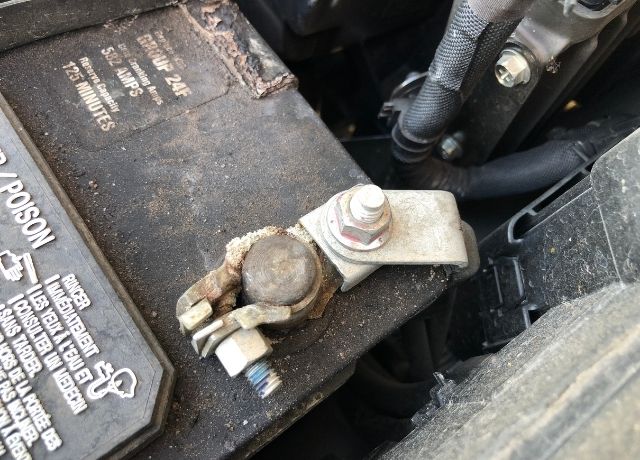
Before you go on a long trip in your old car, you should check the battery terminals. If they’re corroded, you can clean them using baking soda or coke.
You can also keep the connections from rusting by putting a thin layer of petroleum jelly on them. This will keep the connections from rusting and make sure the car starts when you need it to.
Before you leave on your trip, you should repair your battery cable if it’s loose, cracked, leaking acid, or damaged in any other way.
Check The Lights:
The last thing you want is for a police officer to pull you over for a broken taillight. Test all of the lights, including:
The Turn Signals
Brake Lights
Headlights
Also, check the wiring harnesses and make sure they’re in good condition.
If you have any doubts about your car’s lighting system, it’s best to have a mechanic take a look at it before driving an old car long distances.
Examine the Windshield Wipers:
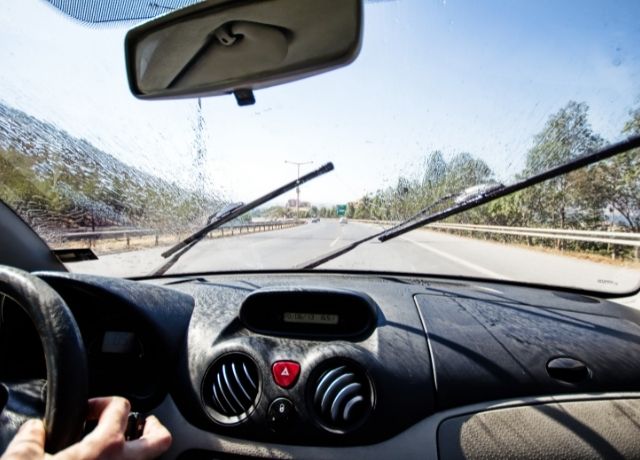
When you’re getting ready to take a long trip in your old car, it’s important to check the windshield wipers. If they’re not in good condition, they can’t do their job properly and you could end up with a nasty accident.
The best way to test your windshield wipers is to use them on a wet surface. Turn them on and watch them as they move across the windshield. They should move smoothly and evenly, without leaving any streaks behind.
If they don’t pass this test, it’s time to replace them.
Also, make sure the windshield washer jets in the front and back are spraying correctly. Washer jets can become blocked and need to be cleaned in some cars owing to little use.
Make sure they’re in good functioning order and don’t need any adjustments.
Car Interior:
The inside of a car, like the exterior, has many components that require regular maintenance. These parts can wreak havoc on your driving experience if they aren’t properly maintained.
That’s why it is essential to do all the car interior maintenance as well before you start maintaining your old car for a long trip.
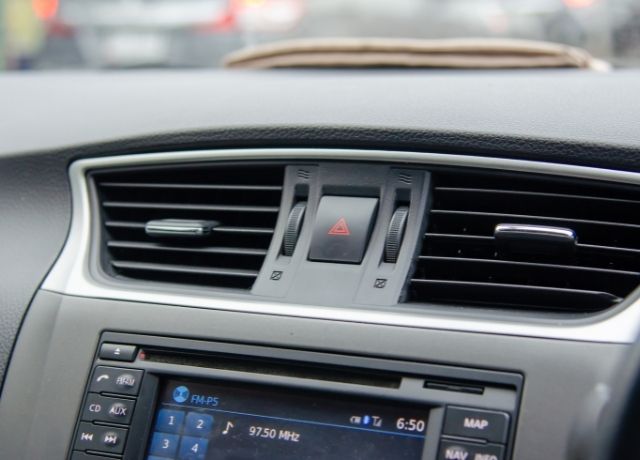
Check Heating and Air Conditioning System:
Some people might think that as long as the car works well, they are good to go. But a malfunctioning heater or air conditioner can make a long trip very uncomfortable and unsafe for the car.
First, it’s important to make sure that the heating system is working well. Imagine being stuck in your car in the freezing cold without any way to warm it up.
Additionally, a lack of heat can cause foggy windshields, reducing visibility and putting you at risk on the road.
Second, making sure that the air conditioning in your car is working right will also make your trip more enjoyable.
Sitting in a hot, stuffy car for a long time can make you tired and make it hard to pay attention while driving.
Before going on a long trip in an old car, the driver needs to take the time to check the heating and air conditioning systems. This is important for both comfort and safety.
Check Cabin Air Filter:
The air in your car is important, even if you don’t think about it. Every time you drive, you and everyone else in the car breathe it in. That’s why you should check your cabin air filter and, if needed, change it.
The cabin air filter is responsible for cleaning the conditioned and heated air that enters the cabin.
- Pollen
- Dust
- Other Airborne Pollutants
are effectively removed.
Regardless of the condition outside, these filters play a crucial part in keeping the air inside clean.
It’s a good idea to examine the cabin air filter before going for a long trip in your old car. You can replace the dirty filter, to enjoy breathing clean air and improved airflow in the interior.
Check the Seat Belts:
While preparing an old car for a long trip make sure that the belts are taut and in good condition. Check the anchors, as well. If they are rusty or damaged, replace them before you hit the road.
Also, make sure that the seat belts are properly adjusted for each passenger. You don’t want them too tight or too loose – just snug enough to keep everyone safe in case of an accident.
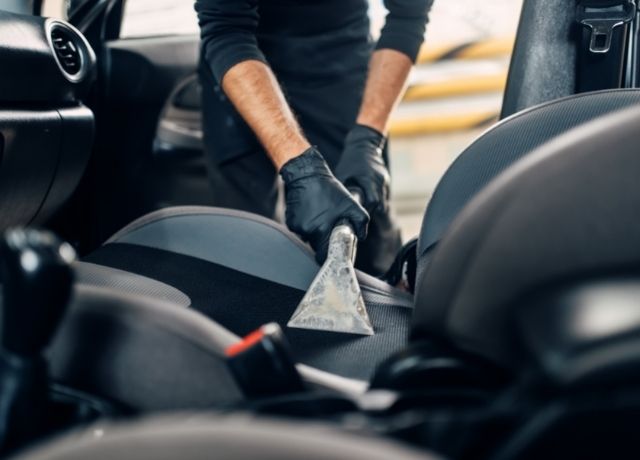
Clean the Interior:
Your long-awaited family trip won’t be as much fun in a car that smells bad. This will help the car stay in good shape and make it easier to drive.
First, you should vacuum the seats and rugs. To get rid of all the dirt and dust, use a soft brush. Then, use a cleaner to get rid of any marks or spots.
Buy an interesting air freshener. Air fresheners not only make your car look better, but they also make the inside smell good. Because of this, you will have a lot more fun while driving.
That’s all you need to check on the inside of an old car as you get it ready for a long trip.
Car Tires:
Just like the exterior and interior, there are a few more checks you need to do while you prepare high mileage car for road trip.

Inspect the Tires:
If you’re like most people, you probably don’t think much about your car’s tires until it’s time for an oil change or tune-up. But if you’re taking a long trip this summer in an old car, it’s important to check the tires and make sure they’re in good shape.
Check each tire on its own. Look for any signs of damage or wear, and make sure they have enough tread to get you to your destination safely. Around the whole tire, the tread level should be at least 1.6 mm, and if it’s less than that, it’s time to get new tires.
Grazes from kerbstones are common and usually not a big deal. However, wheels that are bent or have big dents may need to be fixed or replaced. Also, there shouldn’t be any cuts, splits, or bulges in any of the tires.
If you’ve driven the car for more than 45,000 to 50,000 miles on the same tires, it may be time to replace them.
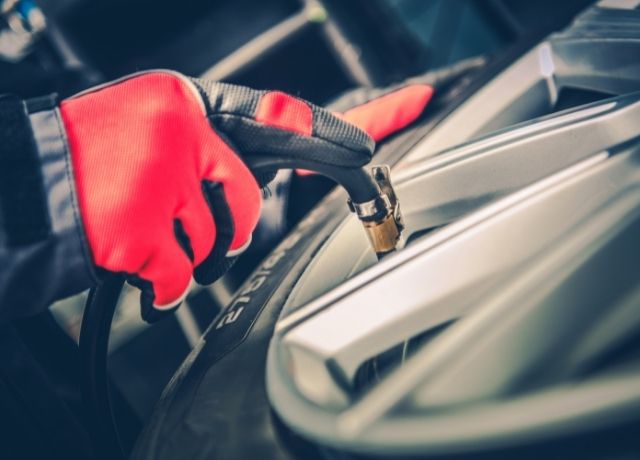
Tire Pressure:
Check the tire pressure on an old car before you take it on a long trip. Underinflated tires can waste more gas and wear out faster, while overinflated tires can make it hard to control the car.
The best way to find out what the recommended tire pressure is for your car is to look in the owner’s manual or on a sticker on the driver’s side door opening.
If your car is more than a few years old, it’s a good idea to add 3–5 psi to the suggested pressure. This will help make sure your tires don’t blow out on those long highway stretches.
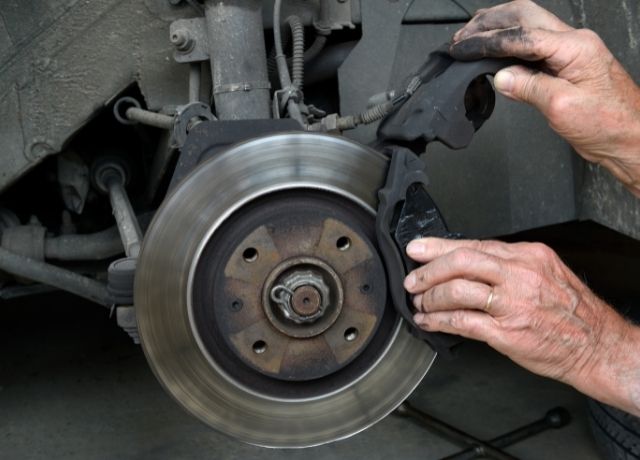
Check Brake Pads:
When getting a car with a lot of miles ready for a road trip, the brake pads are the most important safety check. If the brake pads are worn out and need to be changed, it’s best to do so.
You can hire a mechanic to change the brake pads, or you can do it yourself if you have some technical knowledge.
Tire Rotation:
Tire rotation is an essential maintenance step as it increases your safety on the road along with extending the life of tires. Tire rotation involves the repositioning of tires for even tread wear.
You can consult a professional to rotate tires for you, but you can also rotate tires at home. All you need is to follow a proper pattern.
That was all you need to check in your car tires while preparing an old car for a long trip.
Important Things to Keep In Your Car:
There are a few important items you should always have in your car, especially if you’re planning on going on a long trip in your old car. Some of these items are necessary for safety, while others are just better to keep.
Here are some of the most important things to keep in your car:
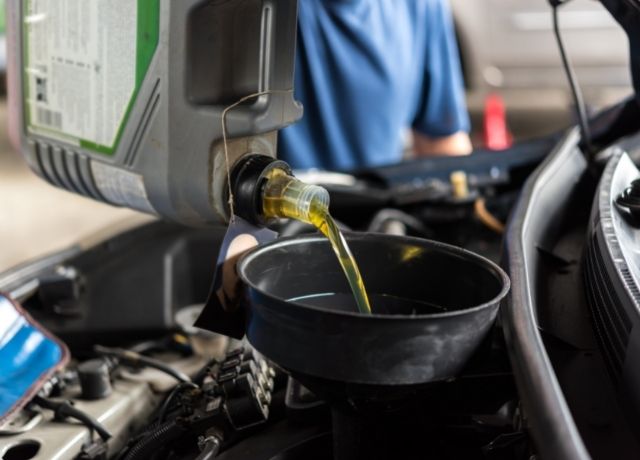
Keep Engine Oil In Your Car:
When you drive a car, you use up some engine oil. Because of this, the engine oil amount goes down. When you drive with too little oil, the engine can wear out faster.
The best way to prevent this problem is to keep a bottle of extra motor oil in the car at all times.
While you’re away, make it a point to check the oil amount every three days. If the number goes down, add more. This small step can help you avoid fixes that will cost a lot of money in the future.

Emergency Repair Kit:
If you’re planning on taking a long trip in your old car, it’s important to prepare it for the long journey. One of the most important things you can do is to create an emergency repair kit.
This kit should include all of the essentials you might need in case of a breakdown or other roadside emergency.
If you don’t have an emergency repair kit with you, you can also make one for yourself.
A basic emergency repair kit includes:
- Jumper cables
- Tire inflator-sealer
- Flashlight
- A couple of rags and gloves
- Basic tool kit with screwdrivers, pliers, and set of most common sockets
- Tire pressure gauge
- Flashlight
- Emergency stop sign
- Flares
- Tape
Keep a bottle of windshield fluid in the car just in case. It’s also a good idea to have a spare ignition key on hand.
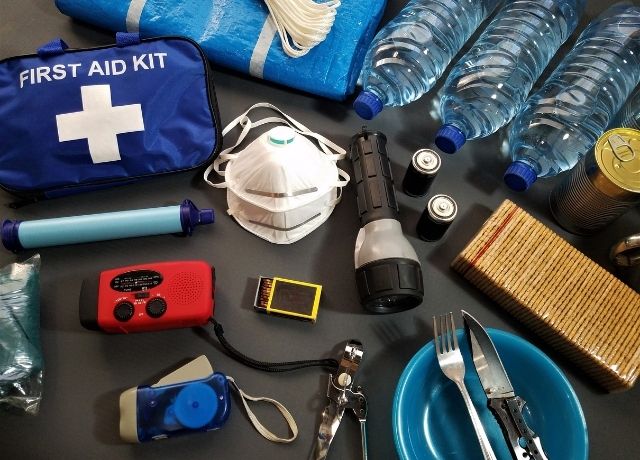
First Aid Kit:
Most people say that their car is one of the most important things in their lives. Every day, you depend on it to get you where you need to go. So, what happens if your car breaks down on the way to your destination? Or, even worse, what if you get hurt?
That’s why you should always get an old car ready for a long trip as if the worst will happen. Keeping a first-aid kit in your car is one way to do this.
So, if something happens, you’ll have everything you need to take care of yourself or someone else.
But what should go into a first aid kit for cars? Well, that depends on your needs. But generally, some of the basics include the following
- Bandages
- Scissors
- Antibiotic cream
- Anti-itch cream
- Anti-bacterial gel
- Burn ointment
- Pain reliever, adults and kids
- Allergy medication
- Gloves
- Antacids
- Eye Wash
- Extra required medication
You can get them from any medical store. Buy a bag and keep all these things in that bag in a well-organized manner.
Owner’s Manual:
Having an owner’s instructions in your car is a good idea. You can look something up if you don’t know how it works.
Also, if something goes wrong while you’re on the road, you’ll be able to fix it with the help of the guidebook.
You should also keep an owner’s instructions in your car if you’re getting ready for a long-distance travel with old car. There may be things that need to be done if you want your car to keep running well for a long time.
You can find out what those things are in the owner’s guidebook.
Food and Water:
When you’re getting ready for a long-distance travel with old car, don’t forget to pack food and water for your car. You can face worse situations with a tension-free mind if you have spare food and water in your car.
That’s why it is a great idea to always keep extra food and water in your car.
These are the few essential things to always keep in your car whenever getting an older vehicle ready for a road trip.
Frequently Asked Questions:
Can an old car handle a long trip?
Yes, with proper preparation, an old car can handle a long trip just as well as a newer vehicle.
What should I check before embarking on a long trip with my old car?
You should check the tires, brakes, fluids, lights, and belts to ensure they are in good condition and functioning properly.
How often should I change the oil before a long trip?
It is recommended to change the oil and filter every 3,000 to 5,000 miles or as per your car manufacturer’s guidelines.
Is it necessary to have a professional mechanic inspect my old car before a long trip?
While not mandatory, it is highly recommended to have a professional mechanic inspect your vehicle for any potential issues that could arise during the trip.
Should I carry extra parts for my old car during the trip?
Carrying spare fuses, bulbs, belts, hoses, and a basic tool kit can be beneficial in case of minor mechanical issues on the road.
How often should I stop and rest during the journey?
It is important to take regular breaks every 2-3 hours or whenever you feel fatigued to prevent driver fatigue and stay alert on the road.
What precautions should I take if my old car doesn’t have GPS or a navigation system?
Plan your route in advance using maps or GPS apps on your smartphone. Carry printed directions as a backup in case of any technological glitches.
Are there any additional safety measures I should consider when traveling with an old car?
Ensure you have a fully charged cellphone with emergency numbers saved. Carry essential emergency supplies like water, snacks, blankets, and a first aid kit in case of unexpected breakdowns or delays.
Conclusion:
Getting an older vehicle ready for a road trip is essential to ensuring a smooth and safe journey. By following these steps – checking:
- Tires
- Fluids
- Brakes
- Lights
- Carrying Out Necessary Repairs
you can minimize the risk of breakdowns and other mechanical issues on the road.
Taking the time to prepare your car properly will not only give you peace of mind, but it will also help you avoid delays and extra costs on your trip.
So, before you take your old car on your next journey, make sure to give it the care it needs. Your car will be glad you did.

